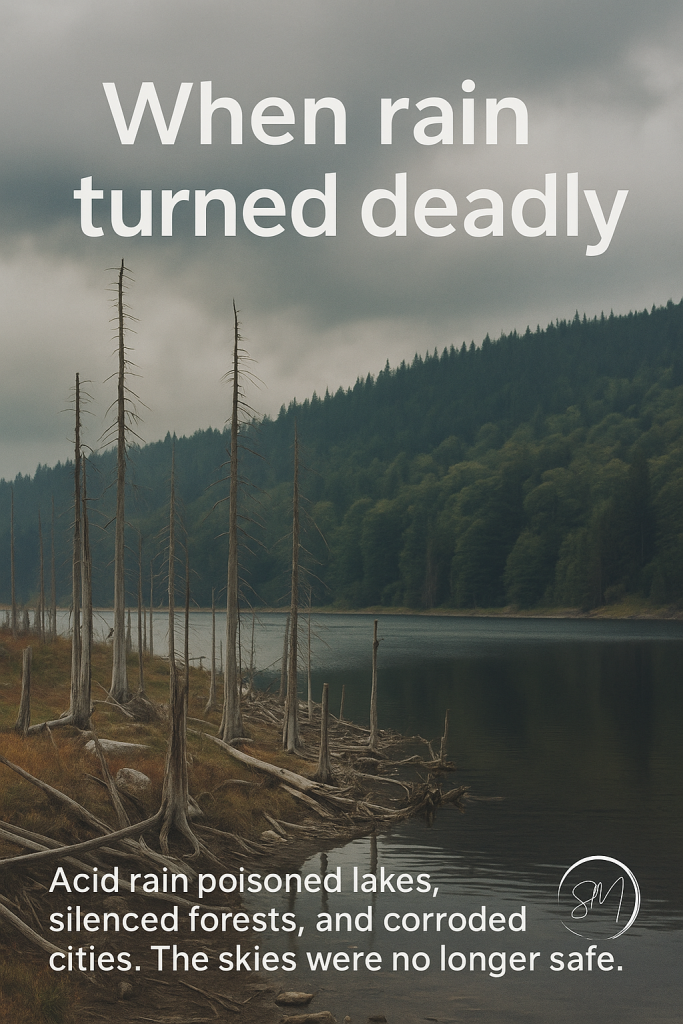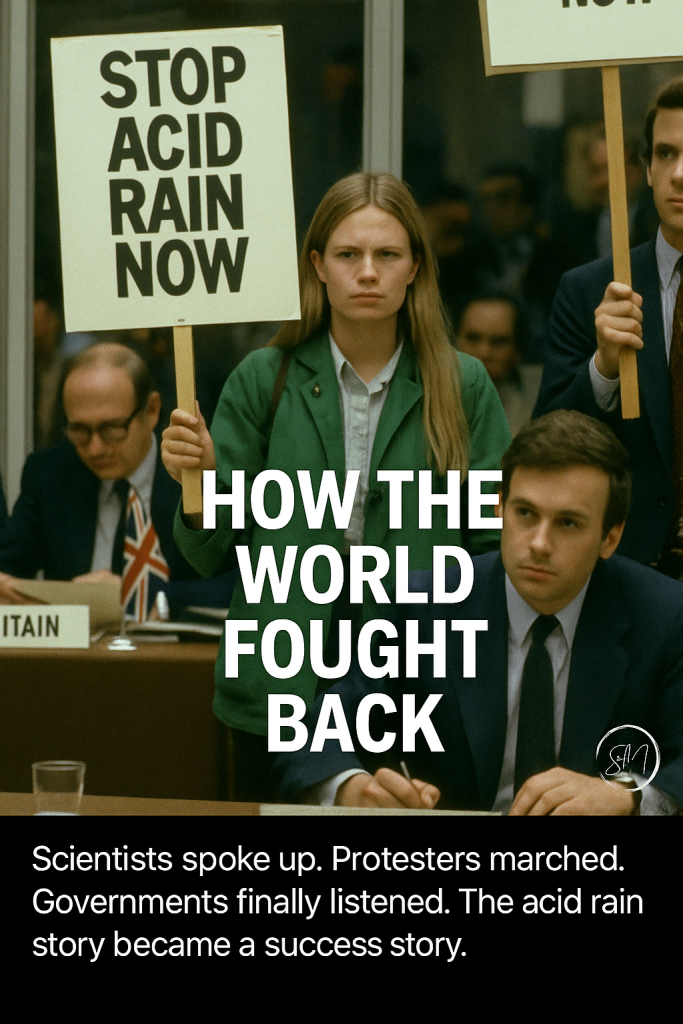In the grimy heart of 19th-century Manchester, a curious chemist began collecting rainwater. The year was 1852, and industrial smoke hung thick over the city. Robert Angus Smith noticed something peculiar—when it rained, the water was more acidic near factories than in the countryside. Twenty years later, in his 1872 book Air and Rain: The Beginnings of a Chemical Climatology, he coined the term “acid rain.” At the time, few paid attention. But this simple observation would lay the foundation for one of the most significant environmental crises of the 20th century.
Today, as climate headlines dominate public discourse, the story of acid rain reminds us that unseen threats can linger for decades before erupting into public consciousness. It also offers a hopeful message: with evidence, activism, and policy, even global-scale problems can be addressed.
A chemical whisper in the rain
Robert Angus Smith was not merely a chemist—he was an early environmental detective. Working under the Royal Commission on Environmental Pollution, his meticulous analysis of rainfall revealed elevated concentrations of sulphuric and nitric acids in industrial zones. Although he lacked the tools we possess today, Smith’s hypothesis was clear: emissions from coal burning released sulphur dioxide (SO₂) and nitrogen oxides (NOx), which reacted in the atmosphere to form acidic precipitation.
This was not theoretical chemistry. The impacts were observable. Metals corroded more rapidly, buildings blackened, and vegetation near industrial towns suffered visible damage. Yet in the Victorian era, the soot-stained progress of industrialisation took precedence over air quality. Smith’s work was largely shelved, his warnings muted by the era’s priorities.
The poisoned legacy of progress
It would take nearly a century before Smith’s acid rain re-emerged, this time as an undeniable ecological crisis. In the 1950s, scientists in Scandinavia began documenting the acidification of lakes and rivers. Fish populations collapsed. Entire aquatic ecosystems blinked out, seemingly overnight. Soil chemistry was altered, releasing aluminium and leaching essential nutrients.
The problem spread. By the 1970s, Germany’s Black Forest showed signs of Waldsterben, or forest dieback, a phenomenon where acid rain weakened trees’ root systems and made them susceptible to disease and harsh weather. In the United States, scientists observed similar damage in the Appalachian Mountains and the Adirondacks. The cause? Acid deposition from industrial smokestacks, sometimes located thousands of kilometres away.
A landmark 1974 paper by Gene E. Likens and F. Herbert Bormann, published in Science, provided hard evidence of widespread acid rain in North America. Their research at the Hubbard Brook Experimental Forest, linked to Dartmouth College and the University of Minnesota, showed that rainwater had pH levels as low as 4, comparable to tomato juice. The science was now indisputable.
From denial to diplomacy
As acid rain gained media attention in the 1980s, it became a geopolitical flashpoint. Canadian scientists and policymakers accused American industries, particularly those in the Midwest, of polluting their air. Emissions from US coal-fired power plants crossed the border, acidifying Canadian lakes and forests. The issue demanded international cooperation, but progress was slow.
In 1979, the United Nations Economic Commission for Europe brokered the Convention on Long-Range Transboundary Air Pollution (CLRTAP), a milestone treaty signed in Geneva. This agreement, involving 32 countries, acknowledged the need to tackle air pollution across borders. Later protocols under CLRTAP would target sulphur emissions specifically, setting reduction targets and fostering scientific collaboration.
However, it wasn’t until 1990 that the United States took decisive action. President George H.W. Bush’s administration introduced amendments to the Clean Air Act, launching a cap-and-trade programme to curb SO₂ emissions. This market-based approach allowed utilities to trade pollution allowances, providing flexibility while lowering overall emissions. It worked. By 2010, SO₂ emissions in the US had dropped by more than 70 percent from 1980 levels.



Science meets society
Acid rain was not just a chemical curiosity. It became a symbol of environmental awakening, spurred by public pressure, media coverage, and scientific advocacy. Images of dead lakes and dying trees entered school textbooks. Documentaries, news reports, and grassroots campaigns captured the imagination of a generation.
What made acid rain resonate? It was visible, measurable, and fixable. Unlike climate change, which unfolds slowly and unevenly, acid rain created tangible damage within decades. And when SO₂ emissions fell, ecosystems began to heal. Lakes slowly regained fish populations. Forests stabilised. Acid rain became an unlikely success story in environmental governance.
The science behind the storm
At its core, acid rain is a product of combustion and atmospheric chemistry. When fossil fuels are burned, especially coal and oil, sulphur and nitrogen are released. These react with water vapour, oxygen, and other compounds in the atmosphere to form sulphuric acid (H₂SO₄) and nitric acid (HNO₃). These acids then fall to Earth as precipitation or deposit on surfaces as dry particles.
The impact depends on local geology. Regions with limestone bedrock, which contains calcium carbonate, can neutralise acids effectively. But areas with granite or other silicate rocks lack this buffering capacity. That’s why places like the Canadian Shield, Scandinavia, and the northeastern US were hardest hit, they couldn’t defend themselves geochemically.
A fragile recovery
While emissions have decreased significantly in Europe and North America, acid rain has not vanished. In rapidly industrialising regions, especially parts of China and India, acid deposition remains a concern. A 2020 study by Dr. Min Hu of Peking University, published in Atmospheric Chemistry and Physics, found that despite SO₂ reductions in eastern China, NOx emissions were still fuelling nitric acid deposition, particularly in urban and agricultural areas.
Moreover, scientists now warn of “nitrogen saturation.” Even in regions recovering from sulphur-based acidification, excess nitrogen from agriculture and transport can disturb ecosystem balance. Forests grow too quickly, outstrip available nutrients, and collapse under their own accelerated growth.
Acid rain also interacts with climate change in complex ways. Aerosols from SO₂ can reflect sunlight and cool the atmosphere. As these emissions decrease, global temperatures may rise more sharply, an unintended side effect of cleaning the air. In environmental science, solutions are rarely simple.
When nature fights back
One of the most hopeful chapters in the acid rain story is ecological resilience. Many ecosystems, once damaged, have shown a remarkable capacity to recover—provided emissions are curbed and human intervention supports restoration.
A long-term study in the UK’s Lake District, led by Dr. Steve Maberly of the Centre for Ecology & Hydrology, published in Environmental Pollution, showed that decades of acidification damage could be reversed. With reduced emissions and targeted liming (the addition of alkaline substances), lakes began regaining biodiversity. Zooplankton returned. Fish spawned again. Water clarity improved.
This reinforces a crucial message: prevention matters, but so does patience and persistence. Environmental damage is not always irreversible, but recovery is often slow and expensive.
The echo in today's skies
The tale of acid rain should not be viewed as a relic of the past. Its lessons echo through today’s environmental battles. Like acid rain, climate change, plastic pollution, and PFAS contamination often begin as obscure scientific findings. They gain public traction only when the evidence becomes overwhelming or the damage is irreversible.
Acid rain also teaches the value of transboundary cooperation. No country can tackle air pollution alone. The wind does not respect borders. The success of CLRTAP and the US-Canada Air Quality Agreement of 1991 offers a blueprint for how nations can collaborate on invisible threats.
And perhaps most critically, the story reveals the power of regulation. Market solutions like cap-and-trade can work, but only when backed by strong laws, scientific monitoring, and public accountability.
From rainfall to reckoning
Looking back, it’s remarkable how a 19th-century chemist’s curiosity transformed into a global policy shift. Robert Angus Smith couldn’t have predicted the scale of the problem—or the eventual triumph of science-backed solutions. Yet his acidic raindrops warned of a larger truth: human progress has costs, and the environment keeps the receipts.
In the age of the climate crisis, we face new forms of invisible rain, carbon dioxide, methane, microplastics, and per- and polyfluoroalkyl substances (PFAS). Each comes with its own chemistry, complexity, and consequences. But the path from observation to awareness to action remains the same.







